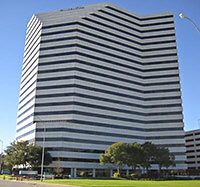UT STUDY: HOUSTON SUFFERING FROM EPIDEMIC OF DILAPIDATED APARTMENTS  A new study from the University of Texas School of Law says that Houston is full of deteriorating apartments, has weak building standards, does a bad job enforcing its own rules, responds slowly to residents who seek help with unsafe homes, fails to keep track of its own building data, and struggles to communicate clearly between departments overseeing different aspects of safety. Houston has the third highest number of occupied apartments in any U.S. city — but of all the complexes in the city, nearly a third are missing Certificates of Occupancy, according to the researchers. The yellow dots on the map above indicate the 1,000-plus multifamily structures that lack the document, which certifies that a building has passed a basic inspection for structural, electrical, mechanical, and plumbing issues. On top of that, the city only employs 2 health inspectors to check for sanitation problems like bedbugs, rodents, mold, and sewage leaks inside Houston’s 320,000 occupied rental units. “In summary,” says the study, “the City of Houston is operating a largely dysfunctional system for addressing tenant safety that appears to have little or no oversight by city leaders.“ [UT School of Law Entrepreneurship and Community Clinic; more info] Map of multifamily properties without Certificates of Occupancy as of July 2017: Texas Low Income Housing Information Service
A new study from the University of Texas School of Law says that Houston is full of deteriorating apartments, has weak building standards, does a bad job enforcing its own rules, responds slowly to residents who seek help with unsafe homes, fails to keep track of its own building data, and struggles to communicate clearly between departments overseeing different aspects of safety. Houston has the third highest number of occupied apartments in any U.S. city — but of all the complexes in the city, nearly a third are missing Certificates of Occupancy, according to the researchers. The yellow dots on the map above indicate the 1,000-plus multifamily structures that lack the document, which certifies that a building has passed a basic inspection for structural, electrical, mechanical, and plumbing issues. On top of that, the city only employs 2 health inspectors to check for sanitation problems like bedbugs, rodents, mold, and sewage leaks inside Houston’s 320,000 occupied rental units. “In summary,” says the study, “the City of Houston is operating a largely dysfunctional system for addressing tenant safety that appears to have little or no oversight by city leaders.“ [UT School of Law Entrepreneurship and Community Clinic; more info] Map of multifamily properties without Certificates of Occupancy as of July 2017: Texas Low Income Housing Information Service
Tag: Government Agencies
WHY YOU MIGHT WANT TO THINK TWICE BEFORE EVEN APPLYING FOR AN SBA LOAN AFTER HARVEY  As lines begin to form at the 3 new disaster recovery centers opened today at the Katy Mills Mall, Greenspoint Mall, and Baytown Community Center, people seeking assistance from FEMA or the Small Business Administration after their homes or businesses were damaged by the storm may want to know about a little HUD rule passed in 2011. Intended to prevent victims from receiving assistance for the same disaster from 2 separate agencies (which had cost the government $1 billion after Hurricane Katrina and the Midwest floods a few years later), the rule ended up going a little further than that: “Every dollar for which disaster victims are approved for an SBA loan is a dollar less they can receive from a federal grant,” reports Danny Vinik in Politico. “In other words, if a victim who is eligible for $120,000 in assistance is offered a $90,000 SBA loan, she can only receive grants worth $30,000—no matter if she accepts or declines the loan.” Complicating the issue for some: low-interest-rate SBA Disaster Loans can provide funds within a few weeks; any outright grants from FEMA would take much longer. [Houston Chronicle; Politico] Photo of ATM at Katy Mills Mall: Cindy D.
As lines begin to form at the 3 new disaster recovery centers opened today at the Katy Mills Mall, Greenspoint Mall, and Baytown Community Center, people seeking assistance from FEMA or the Small Business Administration after their homes or businesses were damaged by the storm may want to know about a little HUD rule passed in 2011. Intended to prevent victims from receiving assistance for the same disaster from 2 separate agencies (which had cost the government $1 billion after Hurricane Katrina and the Midwest floods a few years later), the rule ended up going a little further than that: “Every dollar for which disaster victims are approved for an SBA loan is a dollar less they can receive from a federal grant,” reports Danny Vinik in Politico. “In other words, if a victim who is eligible for $120,000 in assistance is offered a $90,000 SBA loan, she can only receive grants worth $30,000—no matter if she accepts or declines the loan.” Complicating the issue for some: low-interest-rate SBA Disaster Loans can provide funds within a few weeks; any outright grants from FEMA would take much longer. [Houston Chronicle; Politico] Photo of ATM at Katy Mills Mall: Cindy D.

 Kirksey submitted the rendering above in a 4-firm competition to design a general office with some temporary housing for the Saudi Consulate, now occupying a suite in the 22-story Westheimer highrise shown here, which dates to 1982 and sits across the street from an IHOP. But Kirksey lost that competition — to Studio RED.
Kirksey submitted the rendering above in a 4-firm competition to design a general office with some temporary housing for the Saudi Consulate, now occupying a suite in the 22-story Westheimer highrise shown here, which dates to 1982 and sits across the street from an IHOP. But Kirksey lost that competition — to Studio RED.
THOSE EMPTYING GOVERNMENT OFFICES  The federal government is still paying more than $3.3 million a year for the (as of last September) only 21 percent occupied 117,000-sq.-ft. U.S. Attorney’s office at 919 Milam St. Downtown (the lease expires in June 2013; the offices are moving to Wells Fargo Center). And over at Three Allen Center (at left), a much smaller lease for more than 11,000 sq. ft. by the General Services Administration that expires in 2014 is only 1 percent occupied. Those are the top Houston highlights in a report detailing unused office space the GSA is spending big bucks to lease. According to Texas Watchdog reporter Mark Lisheron’s scouring of data unearthed by a report in the Washington Examiner, 103 Texas properties leased by the GSA for government agencies are less than 5 percent occupied. [Texas Watchdog; spreadsheet of Texas leases] Photo: LoopNet
The federal government is still paying more than $3.3 million a year for the (as of last September) only 21 percent occupied 117,000-sq.-ft. U.S. Attorney’s office at 919 Milam St. Downtown (the lease expires in June 2013; the offices are moving to Wells Fargo Center). And over at Three Allen Center (at left), a much smaller lease for more than 11,000 sq. ft. by the General Services Administration that expires in 2014 is only 1 percent occupied. Those are the top Houston highlights in a report detailing unused office space the GSA is spending big bucks to lease. According to Texas Watchdog reporter Mark Lisheron’s scouring of data unearthed by a report in the Washington Examiner, 103 Texas properties leased by the GSA for government agencies are less than 5 percent occupied. [Texas Watchdog; spreadsheet of Texas leases] Photo: LoopNet
 A Swamplot reader who has some familiarity with the terms of the deal has expressed surprise at the 10-year lease the federal government’s General Services Administration recently signed for 132,539 sq. ft. of office space Downtown. The arrangement appears to leave the GSA paying rent on 2 separate Houston office locations for the U.S. Attorney — for 2 years. The U.S. Attorney’s office, located in the office building at 919 Milam since 1994, will move early next year to offices on the 23rd through 27th floors of Wells Fargo Plaza at 1000 Louisiana St. — space formerly occupied by Dynegy, according to a report in Globe St.:
A Swamplot reader who has some familiarity with the terms of the deal has expressed surprise at the 10-year lease the federal government’s General Services Administration recently signed for 132,539 sq. ft. of office space Downtown. The arrangement appears to leave the GSA paying rent on 2 separate Houston office locations for the U.S. Attorney — for 2 years. The U.S. Attorney’s office, located in the office building at 919 Milam since 1994, will move early next year to offices on the 23rd through 27th floors of Wells Fargo Plaza at 1000 Louisiana St. — space formerly occupied by Dynegy, according to a report in Globe St.:
The GSA . . . considered more than 40 potential locations before touring seven buildings and then narrowing it down to four final buildings. Wells Fargo Plaza stood out because of its location, which is two blocks from the federal court building, along with its access to the downtown tunnel system and its 25,000-square-foot floorplates.
The GSA was represented in lease negotiations by the Houston office of Jones Lang LaSalle. Bruce Rutherford is a managing director in the office:
“The building is a short walk to the federal courts, and when it’s really hot or raining, the lawyers can use the tunnel to get there,†Rutherford says, adding that Wells Fargo Plaza is also a “straight shot†by cab if necessary.
But the reasons for the move cited in the article — which include an impending lease expiration, proximity to the federal courthouse, desire for a more efficient use of space as well as enhanced technology and security, and tunnel access — “just don’t add up” for our source, who notes that the Wells Fargo Plaza location is only one block closer to the federal court building at 515 Rusk than the Attorney’s current offices, which also have access to the underground tunnels.

